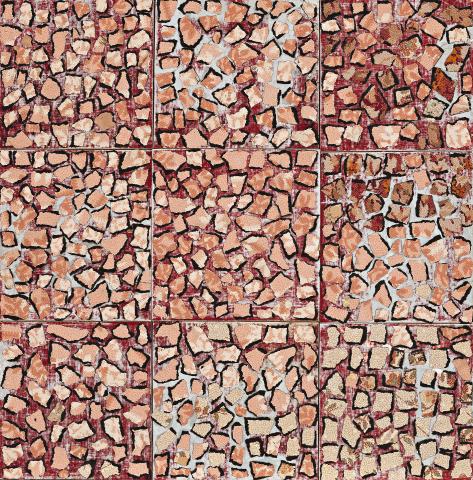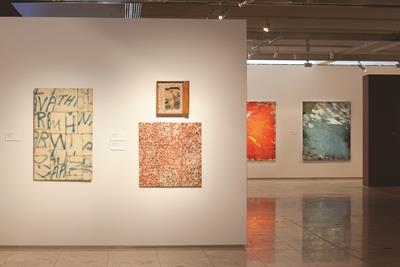ROSE PINK, 1992
ROSALIE GASCOIGNE
linoleum, retro-reflective sign on plywood
83.0 x 81.5 cm
signed, dated and inscribed with title verso: ROSE PINK / Rosalie Gascoigne / 1992
Roslyn Oxley9 Gallery, Sydney (label attached verso)
The Collection of Colin and Elizabeth Laverty, Sydney, acquired from the above in August 1998
Rosalie Gascoigne, Pinacotheca Gallery, Melbourne, 5 – 22 May 1993
Rosalie Gascoigne, Roslyn Oxley9 Gallery, Sydney, 16 – 30 April 1994
Laverty 2, Newcastle Region Art Gallery, New South Wales, 14 May – 14 August 2011
MacDonald, V., Rosalie Gascoigne, Regaro, Sydney, 1998, p. 106
Gascoigne's use of modernist strategies, her simple but complex means of construction – those of fragmentation, re-assemblage, repetition, tessellation and compression – effect an ordering and accentuation which is also poetic in its workings… She experiences, selects and creates, using a relatively narrow range of materials in order to present the work to us resonating with a virtually endless allusive power. Her results are spectacular, exquisite distillations and extractions, grounded in her personalised experience of the land.’1
With her training in the formal discipline of Ikebana complementing her intuitive understanding of the nature of materials, her deep attachment to her environment and later interest in modern art, Rosalie Gascoigne remains one of Australia's most revered assemblage artists. Bespeaking a staunchness and scrupulous eye, her works are artful and refined, yet always maintain a close proximity to the outside world, powerfully evoking remembered feelings or memories in relationship to the landscape; they are ‘instances of emotion recollected in tranquility’ to quote a phrase of Wordsworth's which was so dear to her.
Although inextricably linked in their inspiration and materials to her physical surroundings on the outskirts of Canberra, Gascoigne’s achievements nevertheless encapsulate a larger, more intangible sense of place that is, paradoxically, ‘both nowhere and everywhere at once.’2 Having eschewed the use of iconography, she favors rather allusion and suggestion to capture the timeless ‘spirit’ of the landscape so that her art ‘may speak for itself’, awakening ‘…associations that lie buried beneath the surface of consciousness; inviting a higher degree of sensitivity and attentiveness to the world around us.’3
Occupying that space between ‘the world and the world of art’4, Rose Pink, 1992 is an impressive example of the artist’s assemblages constructed from discarded, sun-baked sheets of linoleum: ‘…terrible stuff really… you don’t see it much, it’s difficult to get. But people used to line their kitchens with it…’5 Despite the material’s obvious domestic connotations however, such works are unequivocally of the ‘outdoors’ – for example, the very closely related Midsummer, 1992 (Private Collection) with its pulsating red palette embodying the searing heat of summer; First Fruits, 1991 (Metropolitan Museum of Art, New York) featuring green linoleum reminiscent of ‘green leaves and apricots in various stages of ripening…that was straight out of Nature. Leafage…’6; Cow Pasture, 1992 (National Gallery of Australia, Canberra) where the floral-patterned medium juxtaposes corrugated iron, characterising the combination of flowers, parsley and manure of cow paddocks; or her monumental Lambing, 1991 with its torn pieces of white weathered lino (‘sheep shapes’) haphazardly arranged to depict the chaos of that season.
Like the best of her achievements, Rose Pink is similarly ‘allusive’ (inspired no doubt by the eponymous floral blooms) yet equally, functions ‘illusively’ as a purely abstract form of art – transcending both the material of its construction and the landscape with its emphatic frontality, use of the grid, and formal interest in qualities of colour, texture and repetition. For indeed, as Gascoigne herself reiterates, ultimately such works are about 'the pleasures of the eye', with her formal manipulations of natural and semi-industrial debris to be appreciated simply as objects of aesthetic delight. Like the materials themselves, beauty is a quality that is easily and thoughtlessly discarded; as John McDonald muses, 'When we value things for their perceived usefulness, we overlook a more fundamental necessity. Life is impoverished by the inability to recognise beauty in even the most humble guise.’7
1. Edwards, D., Rosalie Gascoigne: Material as Landscape, Trustees of the Art Gallery of New South Wales, Sydney, 1998, p. 11
2. Cameron, D., What is Contemporary Art?, exhibition catalogue, Rooseum, Malmo, Sweden, c.1989, p. 18
3. McDonald, J., 'Introduction', MacDonald, V., Rosalie Gascoigne, Regaro, Sydney, 1998, p. 7
4. Edwards, D., op. cit., p. 15
5. Gascoigne, R., cited in MacDonald, V., op. cit., p. 56
6. Gascoigne, R., ibid., p. 58
7. McDonald, J., ibid., p. 7
VERONICA ANGELATOS

